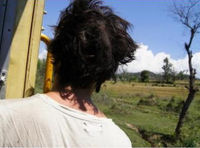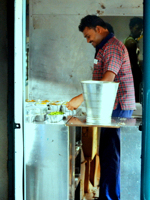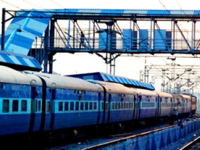Travel India by train
We chug along through fields of wheat and a few small villages, before we start ascending into the mountains, not much faster than the cycles that we can see on the road below that has accompanied us for most of the way. The other unfailing company we’ve had are the large marijuana plants on either side of the track, growing wild and crazy, and they’re almost close enough for us to reach out and pluck some leaves. Lou, the French tourist who’s the only other non-local on the train, is totally delighted, and spends the entire five-hour journey hanging out of the door. “I could never do this in France”, he says. “The trains there are very efficient. But here, it is an adventure.”
 Stick your head out of the window and get some fresh air
Stick your head out of the window and get some fresh airAnushka Meenakshi & Iswar Srikumar
This train is a ‘narrow gauge’, commonly called a toy train, one of the few left in India; most of the others have been converted to broad gauge, to allow for faster trains. It’s all the magic and romance of a train journey, but slowed down and miniaturised, it somehow makes you enjoy the experience so much more.
But that’s not to thump the regular long distance trains. There are over 7,000 passenger trains criss-crossing the country, some through stunning coastal landscapes (try the Mandovi Express from Goa to Mumbai), others like the Kangra Valley Express go through picturesque gorges, valleys and tunnel networks, some are luxury trains especially for the tourist (the most famous one being the Palace on Wheels, but there are many more). Still others go through dusty industrial towns and cities, but every long distance train journey is an adventure waiting to be had, and a distilled experience of everything that is considered typically India – the chaos, the dirt, the great beauty, the food, the sounds, the vendors and of course the warmth and indefatigable curiosity of people.
 Take the delightful toy train to Kangra Valley - well worth the detour
Take the delightful toy train to Kangra Valley - well worth the detourAnushka Meenakshi & Iswar Srikumar
The easiest, but most uninteresting food is from the train pantry car. Far more colourful (and musical) is the food sold at stations. On many of the routes through major cities and towns, the food has gotten standardised in recent years, but on others, the food is fresh, and indicative of local delicacies. So you can try the oranges in Nagpur, the vada pav in Pune, the puri aloo in Central India, the idli dosai in South India, or the sweet petha in Agra, without having to actually visit any of these places. And you can always expect a steady stream of vendors selling local snacks, biscuits, chips, bottled water, and of course, endless cups of chai. Some of the major stations have restaurants that will even deliver the food to your seat - the largest of these chains is Comesum.
Most trains have a transient population – vendors, beggars, street musicians, ticketless travellers, and sometimes, petty thieves, who hop on at one station and get off just a few stations later. So it’s quite vital that you keep any valuables and smaller bags within reach and in sight. Larger luggage rarely gets stolen, but it’s safest to keep it locked and chained to your seat. The most targeted item on these journeys is footwear, which have an incredible and annoying tendency to disappear when you need them the most, so tie them up or stash them out of sight, especially at night.
 A cook prepares the onboard meal in the train pantry
A cook prepares the onboard meal in the train pantryAnushka Meenakshi & Iswar Srikumar
The Sleeper Class coaches (called bogeys locally) are divided into 1.8m by 4.3m (6ft by 14ft) compartments, each with six sleepers (or ‘berths’) on one side, and two side sleepers on the other side of the corridor. The side sleepers are the best for two people travelling together, as they both come with large windows, but they may be a bit cramped for taller people. Of the six sleepers on the other side, the two lower berths are the ones that get the window seats during the daytime, but if you like to sleep a lot or at odd times, it’s usually advisable to book one of the two upper berths.
The set up in the 3rd AC coaches is similar. In 2nd AC coaches, there are no middle berths so each compartment comes with six sleepers. The 1st AC compartments are the most spacious. There are either four or two berths in every compartment, all to one side, with the corridor running along the other side of the coach. These compartments have doors and can be locked from inside, so you get quite a bit of privacy. On longer distance trains, these 1st AC sleepers can be quite expensive, and not much less than a flight fare. There are also the chair-car trains which run on shorter routes, and you get both AC and non-AC coaches in these.
The Rajdhani, Shatabdi and Duronto Expresses are faster trains that run on major routes between large cities. These stop at few stations, or in some cases not at all, so if you’re travelling these routes you’re more or less dependent on the food served from the pantry car on the train (which is included in the price of your ticket), so it’s better to carry some of your own food as well.
Booking India train tickets
 India's train network is efficient, despite its large size
India's train network is efficient, despite its large sizeAnushka Meenakshi & Iswar Srikumar
If you know your plans, the best is to book in advance (you can do this three months ahead of your journey) as trains tend to get filled up pretty fast, especially around festive seasons. But if you’re the last-minute sort, there’s still hope, via the ‘Tatkal quota’, which opens at 8am Indian time, two days before the date of journey. But these tickets are more expensive, non-refundable, and the online system is usually jammed in the morning with everyone, especially travel agents, rushing to buy out the Tatkal quota. There is a provision to get the tickets that you buy online delivered to you, but this is completely unnecessary, you can just print out your e-ticket or carry the electronic version on your mobile or laptop.
If you don’t get a confirmed ticket you may get a WL (wait list) number or an RAC (reservation against cancellation) number. The RAC allows you to travel, but you’ll end up sharing your berth with another RAC passenger. You may end up getting a berth to yourself somewhere along the journey. The WL ticket doesn’t allow you to travel, and you have to check your status a few hours before the train leaves, either online, or at the station, to see if your seat has been confirmed.
 Witness the glories of the Indian countryside whilst travelling by train
Witness the glories of the Indian countryside whilst travelling by trainAnushka Meenakshi & Iswar Srikumar
It’s worth reading all the fine print on the tickets and on the site, so you know all the rules – there are penalties for not carrying your ID and for cancelling your ticket, among other things, and some of the rules keep changing. If you do get fined, insist on an official receipt.
If you’re feeling particularly adventurous, walk into any station and buy the cheapest ticket – for the general compartment. The seats aren’t reserved, and if you’re lucky you’ll get a place to stand next to the loo. Definitely not for the faint-hearted, or for those with a strong idea of personal space.
Read more about the authors' train journey around India on their blog.
Do you have any Feedback about this page?
© 2025 Columbus Travel Media Ltd. All rights reserved. No part of this site may be reproduced without our written permission, click here for information on Columbus Content Solutions.









 You know where
You know where